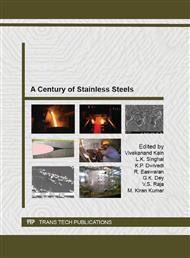p.476
p.484
p.493
p.502
p.507
p.517
p.530
p.539
p.552
Quality Management during Manufacturing of High Tempertaure Thin Walled Austenitic Stainless Steel Sodium Tanks of Prototype Fast Breeder Reactor
Abstract:
Austenitic stainless steels are the major material of construction for the fast breeder reactors in view of their adequate high temperature mechanical properties, compatibility with liquid sodium coolant, good weldability, availability of design data and above all the fairly vast and satisfactory experience in the use of these steels for high temperature service. All the Nuclear Steam Supply System (NSSS) components of FBR are thin walled structure and require manufacture to very close tolerances under nuclear clean conditions. As a result of high temperature operation and thin wall construction, the acceptance criteria are stringent as compared to ASME Section III. The material of construction is Austenitic stainless steel 316 LN and 304 LN with controlled Chemistry and calls for additional tests and requirements as compared to ASTM standards. Prototype Fast Breeder Reactor (PFBR) is sodium cooled, pool type, 500 MWe reactor which is at advanced stage of construction at Kalpakkam, Tamilnadu, India. In PFBR, the normal heat transport is mainly through two secondary loops and in their absence; the decay heat removal is through four passive and independent safety grade decay heat removal loops (SGDHR). The secondary sodium circuit and the SGHDR circuit consist of sodium tanks for various applications such as storage, transfer, pressure mitigation and to take care of volumetric expansion. The sodium tanks are thin walled cylindrical vertical vessels with predominantly torispherical dished heads at the top and bottom. These tanks are provided with pull-out nozzles which were successfully made by cold forming. Surface thermocouples and heaters, wire type leak detectors are provided on these tanks. These tanks are insulated with bonded mineral wool and with aluminum cladding. All the butt welds in pressure parts were subjected to 100% Radiographic examination. These tanks were subjected to hydrotest, pneumatic test and helium leak test under vacuum. The principal material of construction being stainless steel for the sodium tanks shall be handled with care following best engineering practices coupled with stringent QA requirements to avoid stress corrosion cracking in the highly brackish environment. Intergranular stress corrosion cracking and hot cracking are additional factors to be addressed for the welding of stainless steel components. Pickling and passivation, Testing with chemistry controlled demineralised water are salient steps in manufacturing. Corrosion protection and preservation during fabrication, erection and post erection is a mandatory stipulation in the QA programme. Enhanced reliability of welded components can be achieved mainly through quality control and quality assurance procedures in addition to design and metallurgy. The diverse and redundant inspections in terms of both operator and technique are required for components where zero failure is desired & claimed. This paper highlights the step by step quality management methodologies adopted during the manufacturing of high temperature thin walled austenitic stainless steel sodium tanks of PFBR.
Info:
Periodical:
Pages:
507-513
Citation:
Online since:
September 2013
Authors:
Keywords:
Price:
Сopyright:
© 2013 Trans Tech Publications Ltd. All Rights Reserved
Share:
Citation:


